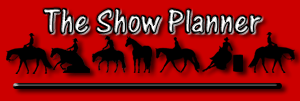 |
|
Show Horse Promotions Mary Murray
|
How Horses SeeThe sense of sight is very important to horses. Like people, horses can see the same scene with both eyes at once; this is called binocular vision. However, the horse can also see separate pictures with each eye; called monocular vision. It is important to know how a horse sees in order to understand why a horse reacts the way it does. Monocular VisionA horse's eyes are set wide apart as compared with a human's eyes. This wide eye position allows the horse to see areas to each side of its body. This increased side vision helps to protect it from predators it can see danger coming from either side without turning its head. Binocular VisionTo judge distances, a horse uses its binocular vision. However, the horse's binocular vision is not as good as its monocular vision. Some horses have better binocular vision than others because their eyes are set closer together. Other horses have to learn to develop their binocular vision through training. One example of this would be teaching a roping horse to follow cattle at the correct distance, teaching barrel horses to judge the distance to the barrel to make a nice smooth turn round it or teaching a jumper to properly approach and jump each fence. Some Facts About a Horse's Vision
© 2000 - 2010 Show Horse Promotions The Show Horse Promotions web site is an informational web site, this information is subject to change without notice. Any use of, or actions taken based upon any of the information contained on this web site is done entirely at your own risk. Show Horse Promotions expressly prohibit you from republishing or redistributing this content without first receiving our written consent. By using this site, you agree not to hold us liable for any errors or delays in this content, or for any actions that you take in reliance thereon. This site contains links to other Internet sites. These links are not endorsements by us of any products or services in those sites, and we have not endorsed or approved any information in those sites. |
|
||||||||
